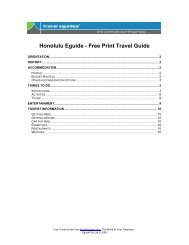Australia Eguide - Travel Guides
Australia Eguide - Travel Guides
Australia Eguide - Travel Guides
Create successful ePaper yourself
Turn your PDF publications into a flip-book with our unique Google optimized e-Paper software.
69<br />
History<br />
Lt Cook (he became a Captain later) first arrived at Botany Bay on April 29, 1770. The<br />
original aboriginal name of the area was Warrane but was to become Sydney, being<br />
named after Lord Sydney, the British Secretary of State for Home Affairs, who had<br />
authorised the colonisation scheme.<br />
The discovery of valuable land west of the Great Dividing Range led to the early<br />
prosperity. By 1842 with the arrival of continuing convicts and free settlers, numbers had<br />
grown to 30,000. In 1848 the British Government stopped the policy of sending convicts.<br />
The flow of immigrants continued as rural people escaped the poverty of Britain. It was<br />
in the 1800's that large scale development started and the Victorian architecture spread,<br />
going up the hill from the harbour.<br />
The 1930's were hard for Sydney but it was a time of celebration with the completion of<br />
the Sydney Harbour Bridge in March 1932. The construction provided a living for many<br />
and had the nickname ‘Iron Lung' due to the fact that it saved so many from starvation<br />
with the earnings workers made.<br />
During the Second World War, Sydney was considered a target by the Japanese. That led<br />
to the deployment of large numbers of US troops in the city. Mass migration followed the<br />
ending of the war and migration continues to this day. The mix of immigrants who<br />
changed over the years now provides Sydney with its very mixed and rich culture.<br />
The grandest building in Sydney, the Opera House was opened in 1973 after many years<br />
construction. In 2000 the very successful Olympic Games promoted Sydney to the world.<br />
Now Sydney continues to develop as a major world city with growing confidence and<br />
strength, helping power the thriving <strong>Australia</strong>n economy.<br />
Museums<br />
<strong>Australia</strong>n Museum<br />
This museum deals with <strong>Australia</strong>n natural history and the culture of the aboriginal<br />
people. 6 College Street.<br />
<strong>Australia</strong>n National Maritime Museum<br />
At the entrance is the welcome hall as a tribute to the millions of migrants who have<br />
arrived in <strong>Australia</strong> over the years. Lots of boats and ships here, including <strong>Australia</strong> II,<br />
which won the America’s Cup, and the huge destroyer H.M.A.S. Vampire. Many vessels<br />
are on the water and include Sekar Aman an Indonesian work boat, HMAS Onslow a<br />
retired submarine,, a commando boat, a 'Little Toot' tug, an 1880's racing cutter and<br />
more. 2 Murray Street, Darling Harbour.<br />
Free from <strong>Travel</strong><strong>Eguide</strong>s.com Online <strong>Travel</strong> Information.<br />
©2008 <strong>Eguide</strong> Pty Ltd




